Leadership & Culture
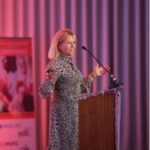
The Appleton Greene Corporate Training Program (CTP) for Leadership & Culture is provided by Ms. Hearn Certified Learning Provider (CLP). Program Specifications: Monthly cost USD$2,500.00; Monthly Workshops 6 hours; Monthly Support 4 hours; Program Duration 12 months; Program orders subject to ongoing availability.
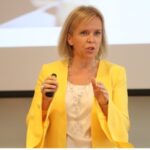
Personal Profile
Ms. Hearn is a Leadership and culture expert with proven success in facilitating transformational changes to ensure business sustainability and creating collaborative culture for organisational development. Adept at articulating learning and development interventions tailored for industry-specific needs. Prominent public speaker with demonstrated ability to leverage communication and interpersonal skills to develop future-proof leaders, cultivate diverse and inclusive workplaces and promote personal development. Strong history of forging trusting relationships with key stakeholders and clients to achieve company objectives. Expert at developing leadership and management training courses, seminars and workshops for C-level executives and employees.
Ms. Hearn has spent 25 years focusing on leadership as a driver of organisational culture, which started with her work as an internal consultant with American Express, leading a very successful culture enhancement initiative across Europe for 4 years.
As an international consultant, speaker, facilitator and executive coach, she’s worked in 25+ countries with clients such as American Express, McAfee, Royal Sun Alliance Group, H&M, Skanska, City & Guilds, Greenpeace, IKEA, MasterCard, SOS Children’s Villages, ABN AMRO and the Royal Bank of Scotland.
Ms. Hearn has co-written three multi-award-winning leadership books: ‘The Team Formula: A Leadership Tale of a Team who found their Way’, ‘Leading Teams: 10 Challenges, 10 Solutions’ and Amazon bestselling ‘The Leader’s Guide to Impact’. A fourth book will be published by Pearson Business in 2024.
She has a degree in Marketing Economics from IHM Business School and an MBA in Leadership and Sustainability from the University of Cumbria and various certifications including Business Sustainability Management at the University of Cambridge, Artificial Intelligence in Business Strategy at MIT CSAIL, and Brain Based Coaching at NeuroLeadership Institute.
To request further information about Ms. Hearn through Appleton Greene, please Click Here.
(CLP) Programs
Appleton Greene corporate training programs are all process-driven. They are used as vehicles to implement tangible business processes within clients’ organizations, together with training, support and facilitation during the use of these processes. Corporate training programs are therefore implemented over a sustainable period of time, that is to say, between 1 year (incorporating 12 monthly workshops), and 4 years (incorporating 48 monthly workshops). Your program information guide will specify how long each program takes to complete. Each monthly workshop takes 6 hours to implement and can be undertaken either on the client’s premises, an Appleton Greene serviced office, or online via the internet. This enables clients to implement each part of their business process, before moving onto the next stage of the program and enables employees to plan their study time around their current work commitments. The result is far greater program benefit, over a more sustainable period of time and a significantly improved return on investment.
Appleton Greene uses standard and bespoke corporate training programs as vessels to transfer business process improvement knowledge into the heart of our clients’ organizations. Each individual program focuses upon the implementation of a specific business process, which enables clients to easily quantify their return on investment. There are hundreds of established Appleton Greene corporate training products now available to clients within customer services, e-business, finance, globalization, human resources, information technology, legal, management, marketing and production. It does not matter whether a client’s employees are located within one office, or an unlimited number of international offices, we can still bring them together to learn and implement specific business processes collectively. Our approach to global localization enables us to provide clients with a truly international service with that all important personal touch. Appleton Greene corporate training programs can be provided virtually or locally and they are all unique in that they individually focus upon a specific business function. All (CLP) programs are implemented over a sustainable period of time, usually between 1-4 years, incorporating 12-48 monthly workshops and professional support is consistently provided during this time by qualified learning providers and where appropriate, by Accredited Consultants.
Executive summary
Leadership & Culture
“Culture eats strategy for breakfast.” Peter Drucker
“People will forget what you said. People will forget what you did. But people will never forget how you made them feel.” Maya Angelou
A healthy organizational culture = a healthy bottom line
Organizational culture is not merely a ‘nice to have’. A recent study by McKinsey of 1000+ organizations showed that those in the top culture quartile achieved 60 percent higher shareholder return than median companies and as much as 200 percent higher return than those in the lowest quartile. This data is supported by a multitude of other studies. Culture matters and culture starts with leaders.
Organizational culture as a concept was first coined in a 1951 book by Elliott Jaques called ‘The Changing Culture of a Factory’, and the concept started appearing in management studies in the late 1970’s. Since then, it’s been a topic of ongoing interest for leaders and organizations, but it’s been more theoretical and conceptual than practical and applicable. Culture has therefore often had the unfair label of being something vague, soft, and ‘fluffy’. That’s not true. Culture is the strongest driving force of an organization. It’s ‘how things get done around here’; it’s made up by explicit procedures as well as implicit behavioural habits. It affects all functions with an organization, the employee and customer experience and ultimately the bottom line. Do culture right and you’ll attract the best employees, loyal customers, and satisfied stakeholders.
There is always a culture, whether you are aware of it or not
Culture can be hard to pinpoint and analyse, but that doesn’t mean there isn’t one. There is always a culture, and the better organizations and leaders understand their own culture and the role cultures plays and how it is created, the more they can influence and shape it.
Take control of the culture and use it as a driver of success
Real, behavioural change, intentionally spearheaded by leaders, to drive culture is still relatively rare. There is greater understanding than ever before that culture is important, which is a big positive, but initiatives to change/influence culture are rarely carried out in enough depth or over enough time to truly change behavioural habits. It takes time and persistence, but it’s worth it. Numerous studies point to the importance of culture, like a recent Price Waterhouse Cooper study where a majority (67%) of survey respondents said that culture is more important than strategy or operations. Their data also shows that there is a discrepancy between what leaders say about culture and what employees actually experience, giving a clear indication that alignment between words and actions are crucial to shape a trustful, healthy, effective culture at work.
Culture is about behaviours and habits
Many organizations realize how important culture is, but few work actively with their culture in a meaningful way, hence missing out on its true potential. Sometimes culture is described as the perks you get as an employee; the space you work in, the fussball table or the coffee station and the Friday after work drinks – or your ability to work from home. But as much as all those things can be expressions of cultural intention, they are not creating the emotional impact on people that behaviours and lived values have. The perks and activities can play a role in employees (and other stakeholders) experience but unless supported by behaviours they become inefficient drives or culture, or merely a fun and relatively superficial activity.
The link to leadership is strong but managers and leaders are so busy with their day-to-day job that the leadership-culture link is often overlooked. Ultimately leadership is the act and art of influencing others. And many people leaders are not fully aware of what impact they are having on people around them and as a result are not aware of what culture they are creating within their teams or their organizations.
Leaders are culture shapers
How leaders behave and what behaviours they accept or overlook in others become the culture. Leaders need to make sure they are consistent by role modelling and rewarding the ‘right’ behaviours – not just because it’s the right thing to do but because of how it impacts employee engagement/experience, collaboration, innovation, customer experience, brand, financial results and more.
The key to real cultural change starts with deep self-awareness, particularly for leaders as their role means they are expected (even if only subconsciously) to set the standard for how things get done. Culture is often implicit, it’s what we see others do, we read between the lines to understand what is expected. If leaders are not aware of what behaviours they are creating in others, it gets difficult to lead. A company’s culture is shaped as much by the behaviours we tolerate or overlook as the behaviours we role model, and this is why leaders need to become great self-leaders and start to reflect on their own habits and practices. Consistency in behaviour is also important as inconsistency tends to confuse and slow things down and even make people cautious and fearful.
Great leaders are excellent self-leaders
When leaders learn how to influence culture authentically and productively, they see that it requires a great deal of self-awareness and self-leadership. Leaders need to understand how their own internal processes of thoughts and feelings ‘leak’ to the world around them and what effect that has. This gives them the ability to shape a culture intentionally and meaningfully where everyone can thrive.
Culture can be actively cultivated in line with organizational vision and values
Organisational culture needs to be on the agenda of every board, executive team, and leader in a very practical way. An understanding of the role of culture in achieving an organization’s purpose and goals can create an alignment in intention and behaviour that fuel results. Leaders at all levels set the tone for ‘how things get done here’. Culture starts at the top but can’t just be dictated from the top. It needs to resonate with people at all levels, as something they would ‘stand for’ themselves. Leaders need to ‘live’ the culture, not just ‘talk the talk’. Leaders who want to maximise the power that is culture, must look to themselves first: How am I behaving? What messages am I sending through my behaviours? What behaviours am I creating in others? And then start changing and adapting their behaviours, creating new habits if needed to create the desired culture, and acting with consistency.
Benefits of a healthy, clear and strong culture
There are many benefits with culture. With a clear, strong, healthy culture, people know exactly how to operate, and this helps them to act with integrity for the good of all constituents, supporting the brand and the brand experience. In a fast-changing world, it allows people to act with integrity and confidence without necessarily having all the answers, supported by the culture. This drives consistent, long-term success, where actions and behaviours are supported by practices and processes. Numerous studies point to the importance of culture, like a recent Price Waterhouse Cooper study where a majority (67%) of survey respondents said that culture is more important than strategy or operations. Their data also shows that there is a discrepancy between what leaders say about culture and what employees actually experience, giving a clear indication that alignment between words and actions are crucial to shape a trustful, healthy, effective culture at work.
Culture needs to be consistent and authentic or it creates costly distrust and disengagement
There are numerous ways for companies to assess cultures today, by studying behaviours and practices and/or rolling out some kind of Employee Engagement Survey, with a focus on employee experience. And there may be customer experience feedback gathered to gain information on how they perceive the organization. These types of surveys can be useful in recognising strengths and development areas, but the outcome often doesn’t go beyond actions and tick lists. They rarely get to the behavioural, habitual change that achieves real change. And in stopping short of real change, which comes down to that behavioural change, very little is achieved. As a result, employees (in particular) tend to feel let down, thinking that the big words about vision and caring about employees (as an example) are just empty talk. This is turn can impact talent retention and ultimately customer experience and at times therefore also loyalty and profitability.
Using leadership and culture to win the ‘war for talent’
Organizations have long faced the “war for talent,” but the recent pandemic made it worse. According to a McKinsey report published in late 2021, 40% of workers were “quite likely” to change occupations within the next 3-6 months. And according to a DDI report, one of the most significant difficulties CEOs confront is finding and keeping top talent.
During the pandemic, many employees started working from home. Several claimed a higher quality of life thanks to reduced commutes and increased family time. People had to pause, reflect, and ask themselves: What is important to me? What kind of life do I want to lead? What activities do I want to engage in? How would I like to work? It’s in our human nature to desire to make a difference and feel like we belong to something bigger than ourselves. A healthy, meaningful culture can make that difference to your organization and help win the ‘war for talent’.
In an increasingly hybrid world of work, the role and importance of culture is at the forefront of organizational success. When people don’t see each other every day, the culture is harder to see and experience, and therefore requires more focused attention. Before remote/hybrid working became a trend in many industries a lot of the culture could be picked up in daily interactions, but if we can’t see it, we don’t really know it and we can’t do it.
Organizations and leaders want to get practical by having culture theories and concepts translated into practical steps that will make a difference.
This program takes leaders through a step-by-step process of becoming effective leaders as culture shapers; to build self-awareness (including strengths, stressors, energisers etc) and social awareness. It will guide leaders on how to effectively choose behaviours, understand, and authentically shape culture, build collaborative environments and stakeholder experience and engagement, hence more effectively and consistently driving business outcomes and results.
Curriculum
Leadership & Culture – Part 1- Year 1
- Part 1 Month 1 Culture Theory
- Part 1 Month 2 Leader’s Role
- Part 1 Month 3 Social Awareness
- Part 1 Month 4 Infrastructure & Behaviours
- Part 1 Month 5 Communication & Storytelling
- Part 1 Month 6 Team Dynamics
- Part 1 Month 7 Hybrid Culture
- Part 1 Month 8 Organizational Development
- Part 1 Month 9 Stakeholder Management
- Part 1 Month 10 Coaching & Learning
- Part 1 Month 11 Collective Intelligence
- Part 1 Month 12 Merging Cultures
Program Objectives
The following list represents the Key Program Objectives (KPO) for the Appleton Greene Leadership & Culture corporate training program.
Leadership & Culture – Part 1 – Year 1
- Part 1 Month 1 Culture Theory – “Culture eats strategy for breakfast” is a quote often attributed to renowned management consultant Peter Drucker, who pointed out that the best strategies and plans in the world will fail unless the culture of the company encourages/supports people to implement it. The first workshop sets the scene for the program by exploring what culture is, what the driving forces of culture are and how culture impacts on business results. We look at the facts of culture and debunk the myth that culture is something vague, soft and ‘fluffy’. As culture is ‘how things are done around here’ this needs to be intentionally shaped to be in line with vision, purpose and values, and to drive desired business results. Culture can be created, it can be changed, and it can be shaped and enhanced, and this requires understanding of the dynamic and how to do it. An important part of this is about populating the values, truly bringing them to life. Many organizations struggle with living the values, which often comes down to things like work processes and practices that are counterproductive to the values. We discuss how living the values can become reality, in an authentic way. We also look at examples of companies that have successfully built strong, clear, healthy cultures, what results they have achieved and what we can learn from them and implement for ourselves. Participants get to observe and explore the concept of culture in general terms and then apply insights to their own setting specifically.
- Part 1 Month 2 Leader’s Role – In the second workshop we start to look at leaders’ roles in shaping the organizational and/or team culture more specifically. We explore how leadership behaviours are ‘contagious’ (others do as leaders do, rather than what they say) and how leaders can be observant and choose to authentically behave in a way that creates the desired culture in line with company values. A large part of leaders’ impact starts from within, what leaders think and feel, their beliefs and mindset will impact their behaviours and habits. We therefore discuss self-leadership and how beliefs, thoughts, feelings, strengths etc drive people’s behaviours and what leaders can do to take control over the impact they have and the culture they cultivate in their daily business dealings. Effective, impactful leaders are great self-leaders, they use their emotional intelligence to understand themselves, including their stressors and energisers, so that they can lead and manage themselves with intention to achieve desired results, rather than just letting the ‘autopilot’ run the show. Participants therefore also get to start thinking about their own impact and are asked to reflect on their own habitual behaviours and the results thereof. Moreover, they are strongly recommended to review any existing feedback and/or are encouraged to collect additional feedback from key stakeholders to understand what others’ experience when they interact and work with the leader. A structure for this feedback gathering is provided. The feedback is used to start building a ‘Leadership & Culture’ development and impact plan. This plan becomes the practical roadmap for the rest of the program.
- Part 1 Month 3 Social Awareness – In the 3rd workshop, the concept of emotional intelligence is further explored by focusing on and practicing social awareness. Social awareness is the desire and ability to observe and be aware of what’s going on around us, to want to understand the world we operate in, the people we work with, our overall surroundings. Like everything else, this can be practiced and perfected and made into a meaningful habit. Being socially aware engages habits like scanning what’s going on around us; listening to the news, learning more about market trends and competitors and potential partners, staying up to date with the industry and the world. It’s also about building habits of listening with interest, asking relevant and explorative questions to understand what others know, experience, want and can contribute. And it’s about putting feedback loops in place to continuously understand what is going on (inside and outside of the organization), the experience of stakeholders, what the team/organizational culture is really like, how effective it is, and how people respond to that culture and what that leads to. Heightened social awareness allows leaders to act and behave with more insight, hence being able to resolve challenges, spot opportunities and engage with others based on their unique situation (rather than assuming that everyone is in the ‘same place’). Leaders who are socially aware can shape a culture where people feel seen, heard and important, which drives stakeholder engagement. We also work on the importance of “walking the talk” when it comes to culture and acting and behaving with consistency.
- Part 1 Month 4 Infrastructure & Behaviours – In the 4th workshop we build on the self and social awareness created in previous workshops and get more practical about how to apply those insights. It is a common misconception that culture is difficult to change and that is also the reason many cultural change efforts never even get started. One reason for people thinking it can’t be done is because they don’t know how to do it, or they have tried doing something, but it didn’t render the expected results. Changing a culture isn’t easy, that’s correct, but that doesn’t equate to impossibility. Changing a culture does require dedicated work though, but with the right focused attention and patience, it can most certainly be done. In this workshop we look at successful examples of how culture have been created, shaped, or enhanced with a combination of activities and infrastructure that supports the culture, in parallel with and supported by daily behavioural habits. What these examples show is how leaders can use culture as a driver of success, not a ‘nice to have’ but a crucial component that can be woven into business processes and practices and therefore into people day-to-day work. The more leaders understand about the power of culture as a driver of success, the more appealing and business critical it becomes to pursue culture as a business success strategy, and then plan how to achieve it. The participants work together to explore how this can look and how to create habits that support business processes and infrastructure, and vice versa.
- Part 1 Month 5 Communication & Storytelling – In the 5th workshop we turn our attention to communication as a culture shaper for leaders. We discuss and dive into practical examples of what role communication really plays in culture. How can you communicate in a way that drives the habits of a healthy culture? Exploring this from different angles, we start by looking at verbal communication and the world of linguistics by identifying words and sentence constructions that engage people in conversation, achieve buy-in and commitment. We also look at non-verbal communication and the power of body language and tone of voice to connect effectively with others. The effect of non-verbal language is often overlooked and unless used with awareness and intention it can often be counterproductive to the verbal communication. Another area of focus is Storytelling, the ability to not just relay facts but context and an overall story that can engage people’s imagination and understanding. People also tend to remember stories better than mere, sometimes dry, facts. We study some of the most powerful speakers in the world to recognise patterns of cultural influence and impact, and what we can learn from that. The participants reflect on their own communication with different stakeholders and what culture they are currently creating around them through their communication. Then we turn our attention to how to communicate in a way that enhances and support the culture, where the participants get to identify the stories that make a difference in their specific situation with their stakeholders to whom they are culture shapers.
- Part 1 Month 6 Team Dynamics – In the 6th workshop we focus on teams and how to create a culture of collaboration and teamwork. This is not just about teams that work together all the time, it’s also about project teams that may only spend a short period of time together but still need to have a collaborative culture to deliver on goals and to schedule. The interaction between team members dictates the team culture, and this should of course be the focus of every person who leads the team. Everyone on a team has a responsibility for the team culture and team spirit, but as covered in previous workshops, leaders have the biggest responsibility here. As a leader you need to make sure that the interaction between people who have a shared purpose and mission (the reason they are a team) is healthy; respectful, honest, collaborative and goal focused, so that they can fulfil their purpose and complete their mission. To do this in a practical way we analyse 10 common team challenges, which unless addressed often derail teams, create conflict and misalignment. The challenges include things like creating trust, managing change, delivering as expected and going in the same direction. We dissect proven solutions to overcoming the challenges and the effect that has on culture and business results. The participants are asked to identify the challenges that are most relevant to their team or teams and then get to populate their ‘Leadership & Culture’ development and impact plan with the team specific actions, behaviours and communication.
- Part 1 Month 7 Hybrid Culture – In the 7th workshop we build on the concept of teamwork and look at teams that have a remote/hybrid work setup. This is something that many companies have subscribed to in the wake of the global Covid pandemic and are continuously working to optimise and make effective. The jury is still out on what the perfect work setup is, and this will of course vary from company to company due to various circumstances such as job roles, location, and local expectations. What most organization have noticed though is that culture needs a different level of attention when people work remotely or don’t see their colleagues every day. In an increasingly hybrid world of work, the role and importance of culture is at the forefront of organizational success. When people don’t see each other every day, the culture is harder to see and experience, and therefore requires more focused attention. Before remote/hybrid working became a trend in many industries a lot of the culture could be picked up in daily interactions, but if we can’t see it, we don’t really know it and we can’t do it. In this workshop the focus in on how to provide the consistency of culture alive when working remotely or in a hybrid setup. Depending on the participants’ own work setup, they get to hypothesise or practice how to, with continuous communication and by intentionally bringing people together for meaningful interaction (be it online or in person), shape and recreate a strong, collaborative, healthy culture.
- Part 1 Month 8 Organizational Development – In the 8th workshop we take a very strategic approach to culture, by thinking about culture as a factor for attracting investors, employees, and partners. We think as strategic consultants by recognising organizational culture’s role in the external perception of an organization. The culture isn’t just experienced internally, it can also be seen and experienced outside of the company too. In fact, it is often said that you can sense a company’s culture as soon as you enter a building, based on how you are greeted at the reception or how you see and hear people talking to each other as you sit and wait to be admitted to a meeting room. What this means is that ultimately every employee is a ‘culture carrier’ and therefore also a brand ambassador. And brand matters greatly, various studies show that as much as 30-40% of a company’s value comes down to brand and reputation, and that strong brands deliver greater returns to shareholders. In this workshop we explore how you as leader can factor this into your leadership and what culture you create around you by being a brand ambassador and a leader of other brand ambassadors. We look at examples of how this can be done, and the participants get add to their ‘Leadership & Culture’ development and impact plan as they decide on actions to take to be a strategic contributor and brand ambassador to their company’s external perception. This session is all about being a strategic, aware, and responsible carrier of the company culture in the external world with external stakeholders made up by customers, investors, partners, influencers and the overall society.
- Part 1 Month 9 Stakeholder Management – In the 9th workshop we focus on the culture that is created in our interactions with important stakeholders. Effective stakeholder engagement and management is at the heart of all successful business as no-one can be successful without the trust and support of their stakeholders. Stakeholders are of courses all those people that have a ‘stake’ in the work that you do, either because your work is dependent/impacted by them or because your work impacts them. The ability to engage with different stakeholders in a relevant way, to gain support and buy-in, is a must for leaders to excel at, and the more senior a leader gets, the more relevant this becomes. Yes, stakeholder engagement and management is yet another important culture factor – being able to specifically create a trustful, collaborative culture which makes stakeholders WANT to work with you. As we weave in concepts from previous workshops, we work on how to use self-leadership, social awareness, and communication to create constructive and effective stakeholder relationships and business outcomes. We explore the behaviours that build trust and open doors, the sense-making skills that tells the story of why people should work with you, and what you can do as a leader to support your stakeholders so that they can be successful too. The participants will map out their key stakeholders and create or update existing stakeholder management plans to ensure consistent engagement with these key individuals on whom you depend on and/or who depend on you. In addition, impactful actions and behaviours get added to the participants’ ongoing ‘Leadership & Culture’ development and impact plan.
- Part 1 Month 10 Coaching & Learning – “Don’t be a know-it-all. Be a learn-it-all”. This timeless quote by Microsoft’s CEO Satya Nadella highlights the fact that no one can know everything (what a relief!), but that we can learn a lot, and that acting with that mindset creates a great learning environment. In the 10th workshop we build on previous leadership concepts as we focus on how to build a culture of non-stop learning. We live in a fast-paced world of change and VUCA (Volatility, Complexity, Uncertainty, Ambiguity) and sustainable, long-term success is dependent on people learning and developing at that fast pace of ongoing transformation. As the world changes to fast there is no way that anyone can have all the answers, so being open to learning is the only way to secure continued success. This means that for organizations to flourish into the future, they need have a fearless Learning Culture, where people courageously dare to try, fail, evaluate, learn, and go again. This requires an open and supportive culture of generous feedback and experimentation, where people ask for help and give help, where the need to ‘be right’ is nowhere to be seen, where non-perfect results are welcomed for the learning and insight they provide. In this workshop we go deep on how leaders can create a learning culture through ongoing effective coaching, feedforward (feedback that catapults you forward), experimentation, and support. The participants get to practice coaching and feedforward and plan for coaching conversations back in the workplace that drive a Learning Culture.
- Part 1 Month 11 Collective Intelligence – Building on the contents of the previous workshop on a Learning Culture, the 11th workshop takes us through how leaders can trigger and drive creativity and innovation by shaping a culture of collective intelligence. Collective Intelligence is the practice of being smarter together by bringing people together and tapping into the individual and collective brainpower of everyone. We look at proven ways to release creativity and igniting a desire for people to generously share ideas and experience, multiplying the organisational/team collective intelligence and then ability to stay relevant and competitive in a fast-changing world. As discussed previously, a VUCA world demands that organizations pursue learning and ongoing innovation to stay ahead of the game. It’s a question of continuously reinvent the business in some way, to stay relevant, to offer what the market and the customers need. And as everyone is in the same boat, it’s a question of thinking about how to disrupt (challenge the status quo) or end up being disrupted by other business, and leaders need to ensure the culture they shape is one where positive disruption is possible. In this workshop the focus is on the practicalities of being smarter together and how leaders can identify areas of innovation and create a Culture of Collective Intelligence. The participants will reflect on the people they work with, the stakeholders they could bring together to tap into the Collective Intelligence that can keep reinventing how things get done. The output forms another part of the ‘Leadership & Culture’ development and impact plan.
- Part 1 Month 12 Merging Cultures – In the 12th and last workshop, we scrutinise what happens when two companies merge, or on a smaller scale, when two teams merge where there may be slightly different cultures. Even within one and the same organization there can be differing, and therefore potentially conflicting, cultures. Unless carefully and skilfully addressed there can be a real culture clash that is detrimental to collaboration and goal achievement. The cost of culture clashes through non-productive interactions can also be felt. However, a successful merge, reshape or reset of culture can be achieved with focused intention and effort, and the involvement of culture carriers (employees) from the different cultures. We use practical examples and explore how the best of two (or more) worlds can be brought together and what that means for leaders and how they communicate and engage with both or all cultures. Building on the previous workshop on Collective Intelligence there is also an opportunity for further innovation and growth that comes from merging different companies/teams as different practices and outlooks can bring new, fresh thinking that can challenge the status quote. And this is something that leaders can facilitate and bring to fruition. And a healthy culture can speed up the timeline of a merger when conflicting focus and culture are removed. The participants add any final times to their ‘Leadership & Culture’ development and impact plan. We also bring the program to a close with a clear plan on how to keep learning alive, follow through on commitments and measure ongoing results of culture.
Methodology
Leadership & Culture
This interactive program is about the business process of shaping the business culture through leadership and is built on the theory and practice of human impact. You will implement this process of how to work with leadership as a driver and shaper of a healthy work culture across the organization.
The program uses research and practical experience from the world of leadership and culture, making the sometimes theoretical and often perceived as ‘woolly’ topic of culture into a step-by-step actionable journey from awareness via skill building and implementation to intentional, people-friendly and goal achieving leadership.
It uses neuroscience and leadership research to create practical actions and habits for behavioural change to drive the culture.
The first 3 months we explore and deepen our understanding of the link between leadership and organizational culture, how leaders can constructively shape the culture through their leadership, the decisions they make, the infrastructure of business, and their behaviours. This involves assessment of current leadership where participants will be asked to look at any existing feedback they’ve had and/or asking for feedback from key stakeholders. It also looks at business processes and activities that can effectively change/enhance the culture. This process will allow you to identify key strengths and development areas and implement them through your ‘Leadership & Culture’ development action and behaviour plan.
During months 4-5 the focus is on identifying behaviours and actions that can make a difference and how to create/develop them. Specifically, we look at the dynamic of actions and behaviours, and the crucial role of communication.
At this stage the participants will form ‘peer coaching pairs’ who will work together through the program, support and constructively challenge each other and hold each other to account. They will do some work together in the workshops but can also choose to spend program implementation time together outside of the workshops.
During months 6-11 the participants learn how to shape their team and/or organizational culture by taking control of their behavioural impact and action-driven focus on the culture back in the workplace in a consistent way. This entails planning for an implementing an approach for a Learning Culture (which is a must for all organizations in the fast-paced world of VUCA (Volatility, Uncertainty, Complexity and Ambiguity) that we live in, through coaching. It’s also about team dynamics and how to boost collaboration and collective intelligence and drive an innovation culture. You will implement the process across your organization in how to shape culture through leadership.
In the 12th month participants review their own progress as culture shapers, which can include gathering of feedback from key stakeholders (those that gave feedback at the beginning of the program).
There is also focus on how to keep the learning, actions and behaviours, and commitments alive, including with the ongoing support of their ‘peer support pairs’. You will implement a process across the organization in how to follow-through and measure success of leadership as a culture driver.
As this program is about the organizational culture, it can be linked to all of the following departments, but specifically to the highlighted ones: Customer Service; E-business; Finance; Globalization; Human Resources; Information Technology; Legal; Management; Marketing; or Production.
Industries
This service is primarily available to the following industry sectors:

Banking & Financial Services
The financial services industry includes financial institutions like banks, credit card companies, credit unions, insurance companies, accounting firms, consumer finance companies, stock brokerage companies, investment funds, and other enterprises. The industry has seen many mergers over the last few decades, resulting in large companies with more extensive resources.
In the last century, this industry has developed from brick-and-mortar with bank branches and service offices to a much more digital, online industry. Yes, the banking and financial services sector is undergoing a significant change due to the rapid advancement of technology, which has dramatically raised customer expectations and demands in this industry. Customers increasingly expect to access financial services wherever and whenever they want. Together with increased client expectations, this industry also must strengthen internal procedures. These organizations manage a lot of data, including customer information, financial records, account information, and more, the majority of which is sensitive and contains personal data. Due to these factors, it is crucial to use technology to enhance security and boost the effectiveness of data handling and processing.
Financial transactions are no longer the only thing that banking and financial institutions can handle. Financial institutions frequently offer credit insurance or other insurance products as loans are closed or even after the loans are closed today. They need to comprehend market demands and customer preferences as competition intensifies. Modern technology can trigger several client touchpoints. Financial institutions can use the data that customers leave behind when they use the internet to enhance their services and produce better products.
The primary trend for the sector is digital development, with online banking and mobile banking. And Open Banking (UK), PSD2 (EEA) is also becoming a significant trend, making it easier for people to share financial information from their bank with other service providers that they choose (making away with the need to fill in forms and submit such data manually). The US still needs to establish a national open banking framework, and existing open banking is therefore undertaken at the initiative of private banks.
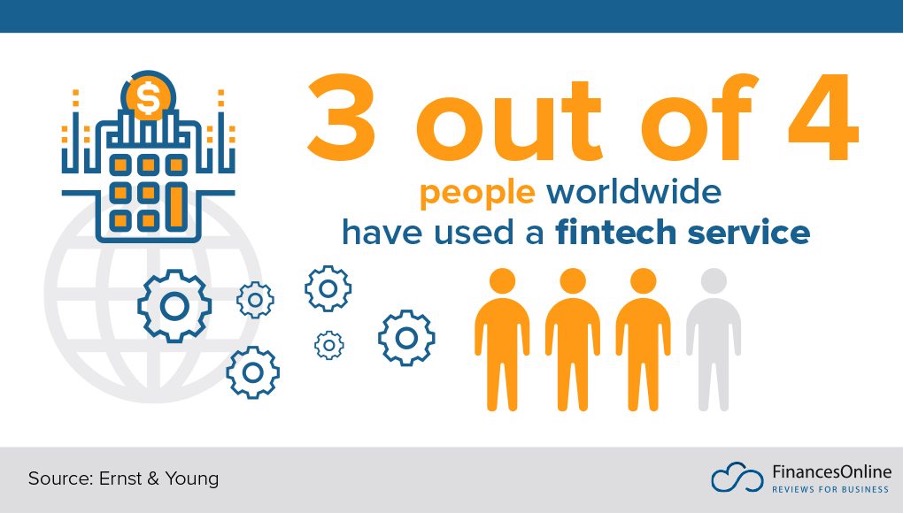
The number of open banking users worldwide is expected to have an annual increase of around 50% between 2020 and 2024, with the European market being the largest, according to Statista.
With the advantages that open data offers to both financial players and consumers, it is simple to see why this movement will gain popularity over time.
Organizations may better understand how consumers behave, what they want, and most crucially, what they need by giving third parties access to their financial data. By enhancing the customer experience, financial institutions may increase client engagement and retention.
PWC states that the following retail client propositions will be made possible or improved by open banking:
• Customized product offerings based on transaction history, such as holiday loans based on reservations for flights and hotels and expected spending
• Better access to financial data will increase the availability of loans for “thin-file” customers.
• Account aggregation offers a unified view of accounts from many institutions.
• Financial management solutions that use data analytics to pinpoint spending trends and increase savings and budgeting efficiency
PwC claims that Open Banking has generated a £7.2 billion income opportunity. Financial institutions are starting to take action as they seek to seize this chance. In 2021, 47% of banks created Open Banking APIs, and another 25% did the same in 2022. By 2023 and beyond, Open Banking is predicted to rule the financial services industry.
Another trend is that banking and financial services, such as supermarket chains and airlines, are increasingly offered by organizations and industries previously not linked to financial services.
Banking-as-a-service (BaaS) is also a growing financial service where legacy banks can open their APIs to third-party providers who can offer new services without a banking licence.
As much as this industry is heavily regulated, there is also a drive for simpler, faster, more straightforward financial, insurance and payment solutions. The existence of ‘challenger banks’, for example, entirely online or with more generous opening hours than before, is proof of this. Legacy banks will likely continue to close branches because of digitalization and changing customer preferences and habits. The financial industry, including insurance, is fast becoming fintech, and digital transformation is revolutionizing how money and related services are transacted.
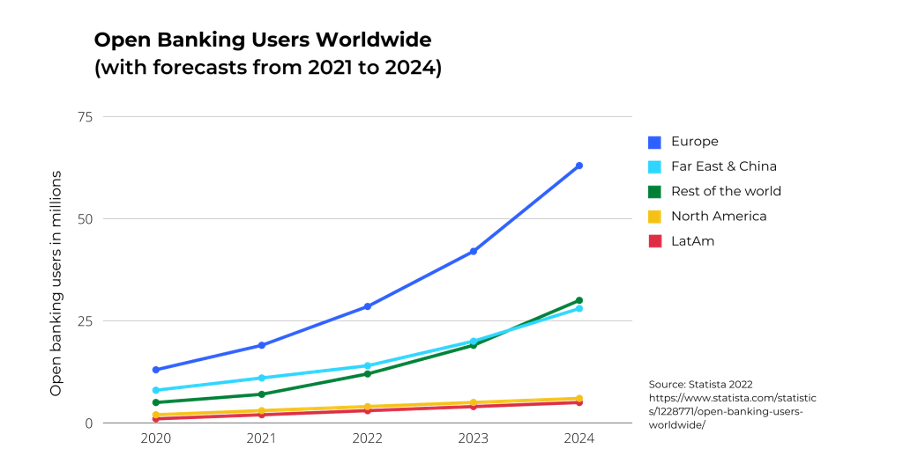
Disruptive technologies, including Artificial Intelligence, will continue challenging how banking and financial transactions and services are done. This means that organizations in this industry must continue their development of agile and innovative leadership, mindset, and practices.
Financial institutions have long placed a high priority on cybersecurity. Financial institutions are particularly vulnerable to cybersecurity attacks. For hackers, their customers’ financial and personally identifiable information (PII) is extremely valuable, and security flaws could cost the bank many clients and money. The number of data breaches up until September 30, 2021, however, is 17% higher than the total number of instances in 2020, making it a more significant issue than ever. The effects of these cyberattacks on organizations are extensive. 42% of companies claim that cybercrime hinders innovation and expansion into new channels.
Technology/IT
The two-element electron tube’s discovery in 1904 catalyzed the development of the technology sector, which is a relatively new field. After this came advancements like the transistor and integrated circuits in the 1950s, and analogue devices in the 1960s. These discoveries were mainly the result of military research. The microprocessors and integrated circuit boards that followed were created in the 1970s, opening the door for home and personal computers in the following years. Yet, computers were not particularly prevalent until the public had access to the internet. When everyone had access to the internet in the 1990s, the use of personal computers skyrocketed. Due to that surge, entrepreneurs like Bill Gates and Steve Jobs became household names. Technology has since progressed to a point where tablets and mobile phones now provide all the functions of a typical desktop computer. Devices are continually getting smaller and more sophisticated due to the revolution that cloud computing has brought about in data storage.
Today the tech industry is a diverse combination of giants such as the ‘Big Five’ Microsoft, Alphabet, Meta, Amazon and Apple, and countless start-ups and scale-ups, many that eventually end up being bought up by the big players.
Businesses that sell products and services in electronics, software, computers, artificial intelligence, and other information technology-related industries make up the technology sector (IT). Tech corporations invest extensively in R&D and might embark on riskier ventures with better long-term prospects. Tech businesses operate platforms like Facebook, Twitter, and Instagram. Businesses rely on the technology industry to support their expansion and success. One of the most desirable growing investment sectors in an economy is frequently the technology sector.
The global market for information technology grew from $8179.48 billion in 2022 to $8852.41 billion in 2023. The confrontation between Russia and Ukraine, at least briefly, limited the likelihood of a COVID-19 pandemic-related global economic recovery.
Data collection and analysis are one of the more recent trends and possibly the future of the technology sector. Many tech companies gather data, ranging from website clicks to GPS-measured dwell times at specific locations to the frequency of product repurchases. Most of the data is unstructured and challenging to evaluate. Still, as analytics advance, it transforms into customer behaviour patterns that will enable businesses to take a proactive rather than a reactive approach.
The digital transformation is continuously changing how technology is used by individuals and organizations and the value that can be added in the form of customer experience and organizational efficiencies. Organizations also become more productive and efficient thanks to machine learning (ML) and artificial intelligence (AI). Massive datasets may be gathered, sorted, and analyzed quickly and nearly error-free by these technologies. Instead of wasting time and effort manually sifting through the data, financial institutions may spend their time acting on these data-driven insights. According to IDC, 25% more productivity will be achieved by 2026 thanks to 85% of organizations using AI and ML in some capacity to improve their foresight. One excellent example is low-code/no-code AI, which enables non-programmers to create apps on their own. The market for low-code development technologies globally is predicted to be $26.9 billion in 2023, an increase of 19.6% from 2022, according to the latest prediction from Gartner, Inc. They also predict that low-code tools will make up 65 percent of all app development by 2024. A surge in business technologists and an increasing number of enterprise-wide hyper-automation and composable business projects will be the primary drivers boosting the adoption of low-code technologies through 2026.
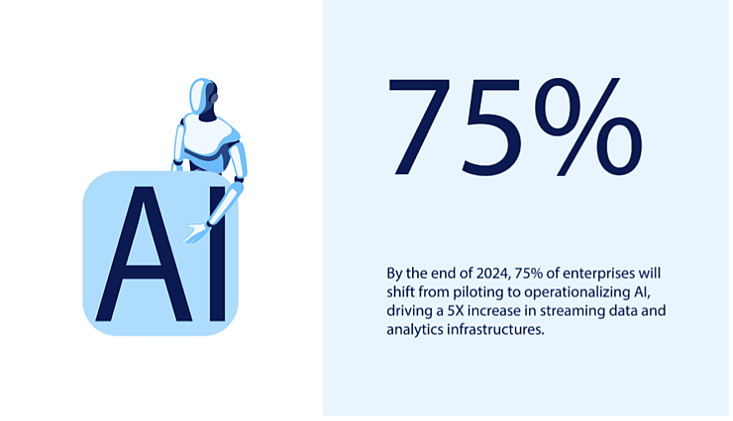
Source: www.litslink.com
As the technological development continues to ramp up, the industry remains strong, and tech talent, education and experience is in high demand. There have however notably been plenty of layoffs in the industry in 2022, some of the most notable ones being Meta, Amazon and Twitter. These have mainly been driven by factors such as the global downturn, inflation, energy costs and political conflict, leading to caution and pre-emptive action.
The industry layoffs have continued into 2023, and this year is likely to be another wobbly year. It will however continue to be an exciting industry with the digital revolution still being in its early stages. Artificial Intelligence is still not moving at the pace that has optimistically been predicted for decades. The industry also struggles with unintended consequences of technological inventions. As we become more and more dependent on technology solutions, the ability to create trust will be increasingly important to the tech industry, as the development of AI continues, and the need for the solutions to be ethical and non-biased. The recent development of ChatGPT has intensified the discussion about the ethics and transparency of AI. In March 2023, hundreds of leaders and experts within the AI/tech industry, including Elon Musk and Steve Wozniak, wrote an open letter asking for the development of AI ‘giant minds’ to be put on hold with immediate effect until such time that it can be deemed safe and responsible. This highlights the importance of ethical, controllable AI development and the responsibility governments worldwide need to take in this space to regulate AI.
After profit and revenue, investors now place environmental and social issues among their top three priorities. To achieve sustainability targets, executives must therefore increase their investment in creative solutions that address ESG demands. To achieve this, businesses need a new framework for sustainable technology that boosts the material and energy efficacy of IT services, enables enterprise sustainability through tools like traceability, analytics, renewable energy, and AI, and deploys IT solutions to assist clients in achieving their own sustainability objectives.

Source:www.nationthailand.com
Cyber threats and crime are also increasing and the need to develop solutions that overcome or at least reduce these are crucial financial institutions have long placed a high priority on cybersecurity. The number of data breaches up until September 30, 2021, however, is 17% higher than the total number of instances in 2020, making it a more significant issue than ever. The effects of these cyberattacks on organizations are extensive. 42% of companies claim that cybercrime hinders innovation and their expansion into new channels. Financial institutions are particularly vulnerable to cybersecurity attacks. For hackers, their customers’ financial and personally identifiable information (PII) is extremely valuable, and security flaws could cost the bank a significant number of clients and money.
Quantum computing is also progressing, promising some of the most exciting development for solving big problems with technology. Computer science’s application of quantum theory is known as “quantum computing.” The behavior of energy and matter at the atomic and subatomic scales is explained by quantum theory. Subatomic particles like electrons or photons are used in quantum computing. These particles can exist simultaneously in two states (i.e., 1 and 0) thanks to quantum bits or qubits. Linked qubits may theoretically use the interference between their wave-like quantum states to accomplish calculations that would otherwise take millions of years.
Technology is transforming at pace, enabling faster progression, and speeding up change. Yet, many more changes have occurred in the last few years due to the COVID-19 epidemic, which has made IT professionals recognise that their job will alter in the contactless world of the future.
And an IT professional will be continually learning, unlearning, and relearning (out of necessity if not desire). As the technological disruption continues, the ability to humanise the experience (for employees, customers, and other stakeholders) becomes more and more important. Tech leaders need to create an agile and innovative culture where people can be at their best.
Locations
This service is primarily available within the following locations:
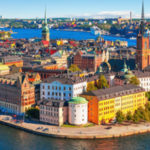
Stockholm, Sweden
In the mid-1800s, an influx of people started following investments in organized cleaning, sanitation, and transportation, and the city of Stockholm grew. Industrial innovation started to blossom, most famously by people such as Alfred Nobel, who invented dynamite, or Gustav de Laval with the dairy separator. Commercial banks were attracted to the city, making risk capital easier to access and laying the groundwork for a blossoming business city.
Today, with around 980,000 residents in the municipality, Stockholm, the capital of Sweden, is the largest of the Nordic capitals. 2.4 million people live in the greater metropolitan region and about 1.6 million in the urban area. More than 22% of Sweden’s population resides in the Stockholm region, contributing around 29% of the country’s GDP. Stockholm’s gross domestic product (GDP) increased gradually between 2010 and 2021. It rose yearly, except for falls in 2012 and 2020, reaching 734,000 Swedish kronor in 2021.
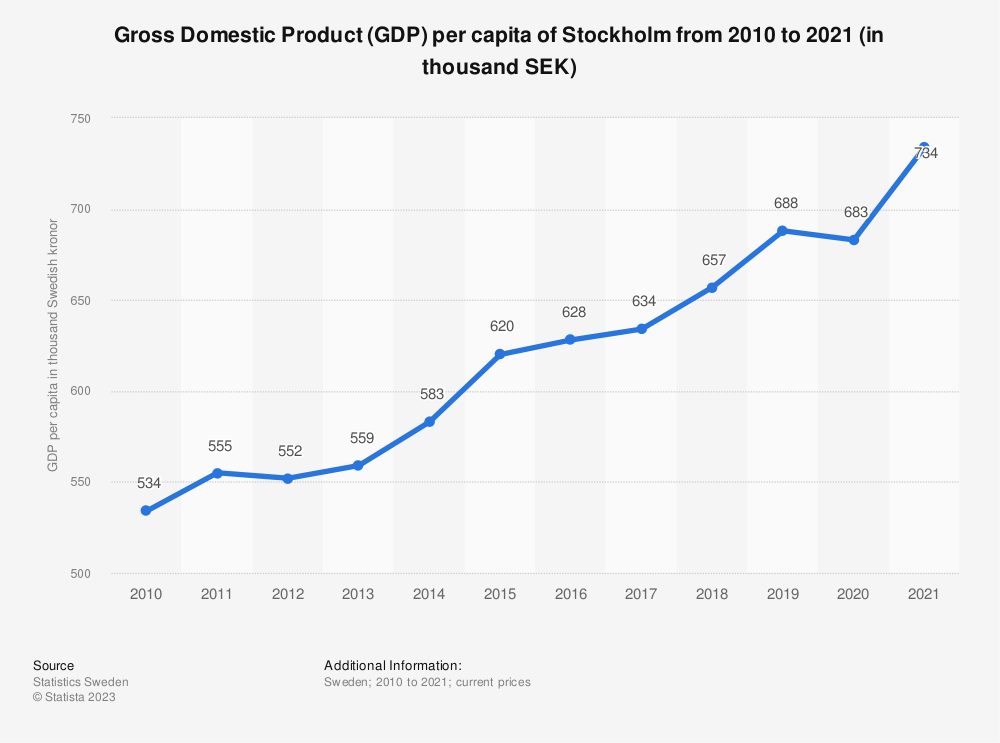
It’s also the leading tech hub in the Nordics. 22 global multinationals (such as Ericsson) have their head offices in the city, with a particular concentration within the information, communication, and technology (ICT) industry and the finance and insurance industry. It’s home to at least 35 so-called ‘unicorns, such as Klarna, Mojang, and iZettle.
The premier ICT cluster in Europe is Kista Science City, on the outskirts of Stockholm. Several of the most well-known ICT corporations in the world, as well as many intriguing start-ups and the top institutions in Stockholm, are in the cluster. The 5G and IoT technologies testbed, the Urban ICT Arena, is located there, making it a venue for future technology as well. The Triple Helix Model—an innovation partnership involving the private, public, and academic sectors—is the foundation of Kista Science City.
Sweden has the second-highest concentration of billion-dollar enterprises per capita behind Silicon Valley. Both Skype and Spotify were founded as start-ups in Sweden. Because it is smaller, Sweden is a great area to test new ideas and products before offering them to more significant markets. Many technology businesses have headquarters in Sweden’s two main cities, Stockholm and Gothenburg, making Stockholm a haven for entrepreneurs.
Building a fiber-optic network throughout the municipality to create a level playing field for all operators (and ensure connectivity for the whole population) was the goal of the city-owned business Stokab in 1994. Roughly ten years later, the network had grown to be the longest optical fiber network in the world, measuring 1.2 million kilometers (0.7 million miles). The local economy has reaped substantial advantages from this. The city has been launching several e-services and lowering costs using fiber connectivity. And Stockholm has progressively risen on the list of world capital cities considered the most business-friendly.
The Stockholm tech scene has made Sthlm Tech Fest a mainstay. This yearly event, organized by Tyler Crowley, a former Bay Area VC Jason Calacanis business associate, attracts approximately 4,500 attendees for three days of the conference, a job fair, and other side activities spread throughout Stockholm. A hackathon was added in 2019, which ended up being the largest female hackathon in Europe, with over 800 participants. Organizations like Nordea Bank, McKinsey Digital, and Microsoft sponsored numerous challenges.
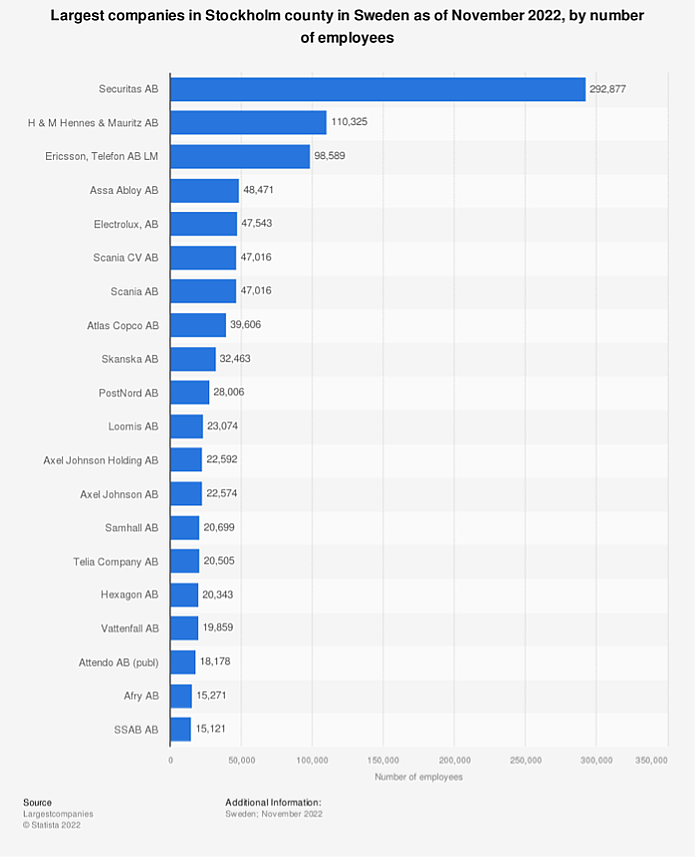
Stockholm is recognized as one of the world’s most creative and rapidly expanding regions. Some of the leading universities in Europe, including the Karolinska Institute, Stockholm School of Economics, KTH Royal Institute of Technology, and Stockholm University, are located in the city. It hosts the luncheon and the annual Nobel Prize ceremonies at Stockholm City Hall and the Stockholm Concert Hall.
Sweden’s economy consistently ranks as one of the best-performing in the world and is the fourth most competitive (think productivity) in Europe.
Sweden is renowned for its robust business environment, global competitiveness, variety of linguistic abilities, and dedication to innovation. This is primarily because of the nation’s free-market economy and advanced educational system. The government promotes innovation and expansion through several agencies and spending on infrastructure. Sweden is also known for fostering cross-border collaboration; more than 3% of the nation’s GDP is allocated to research and development.
Swedish companies have made significant progress in many fields, including digital tools, pharmaceutical development, and biotechnology tools. Moreover, the nation is a global leader in regenerative medicine, orthopaedic implants, medical imaging, and biomaterials.
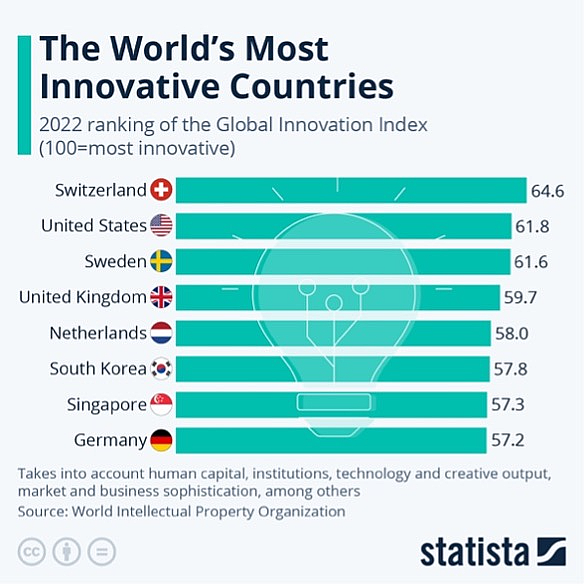
Excellent English-speaking proficiency, ease of doing business, and access to talent and capital are a few reasons for attracting global firms. Stockholm is Sweden’s leading industrial city and has the second-largest port after Gothenburg.
Sweden, which has 94% of its population online and is the country of climate activist Greta Thunberg, outperforms the other Nordic nations and the rest of the globe in reaching the UN’s sustainable development goals. When it comes to investing in start-ups and scale-ups, the sector to watch is ‘impact start-ups’ with a focus on sustainability issues and solving climate and societal challenges. A few such examples are Polestar, Northvolt and Oatly. Green fintech is flourishing, emphasizing sustainable investments, calculating business emissions, and more. Stockholm is a leading example of international environmental and climate change action and one of Europe’s greenest cities.
Stockholm is expected to continue growing and attracting talent and investment capital.
London, UK
London has been a financial powerhouse for a long time. More than half the world’s trade was financed through the British currency at the end of the 19th century. This was followed by a smaller role in the early 20th century, where banking was largely for the British Empire. In 1958 London became a global player again when the exchange controls were relaxed, followed by the 1980’s deregulation of the securities and capital markets. Since the 1990’s London has been one of the leading financial hubs in the world, with all major international banks residing in the City.
This still holds today, and thanks to its blend of world-class culture, entertainment, and shopping, London is a truly global city and a very popular travel destination. Nine million people currently live in London. Because of its 2000-year history, it is highly diversified, lively, and cosmopolitan.
With a population of 270 nationalities and 300 languages, it is one of the earth’s most culturally varied cities. It has an atmosphere and energy surpassing every other region in the UK. This makes it unique to everywhere else in the UK, producing more wealth, functioning in a more stressful and quick-paced workplace, and having a more extensive range of perspectives and background experiences.
During the Victorian era, significant social infrastructure upgrades were made to improve transportation, sanitation, law enforcement, and health care. A large portion of this severely outdated infrastructure currently poses challenges for contemporary development and transportation options.
With a GDP of £503 billion in 2019, Greater London represents about a quarter of the entire economic activity in the UK. London transitioned to a predominantly service-based economy earlier than other European cities, especially after World War II. Around 0.68 percent of the GDP of the United Kingdom in 2021 came from agriculture, 17.49 percent from manufacturing, and 71.46% from services. The services sector, including tourism, fuels the economy and accounts for the vast bulk of the UK’s GDP. The headquarters of more than 100 of the 500 largest corporations in Europe are located in central London, as are more than half of the top 100 listed companies in the UK (FTSE 100).
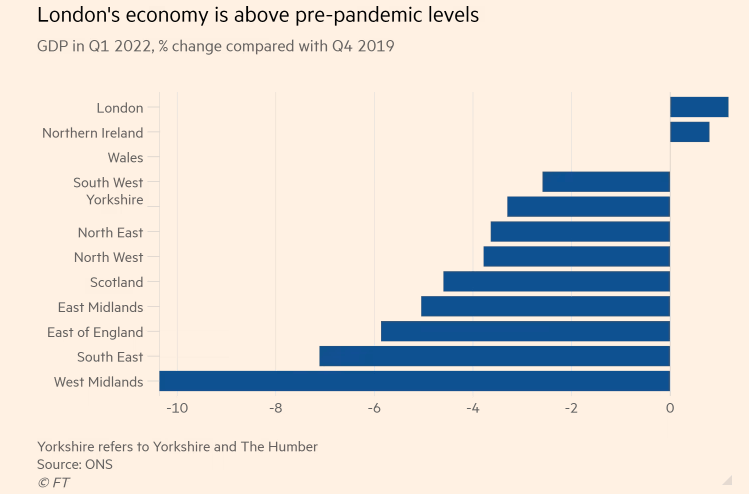
With an annual economic output of almost £85 billion, the City powers the economy. 1 in every 54 GB workers, or 587,000, works in the City of London. Every fifth position in the financial services sector in the UK is in the City. From pre-pandemic 2019 to 2021, city jobs increased by more than 8%, adding approximately 45,000 positions compared to 2019. The City produces £1.1 billion in business rates, supporting the national economy.
Prominent employment outside the financial sector includes those in the hospitality, food, arts, entertainment, and retail industries. The main economic drivers are banking, finance, brokerage, insurance, and legal services.
Outside of central London, the economy is led by IT services, healthcare, and education, which employ over one in four people. London’s importance as a global transportation hub stimulates demand in the transportation and storage, wholesale, manufacturing, and utility sectors.
Ernst & Young estimates that 7,000 jobs and £1.3 trillion ($1.5 trillion) in assets were lost from the financial services sector, which employs 1.1 million people, manages investment funds worth £11 trillion, and holds banking assets worth £8.3 trillion. This constitutes less damage than many had feared. Despite Brexit and significant assets being moved to other countries, London remains one of the leading financial cities in the world. And it is one of the biggest tech cities in the world. However, having left the EU impacts the influx of European talent, and some companies have moved part of their business to English-speaking Dublin, Ireland.
The United Kingdom’s exit from the EU and frictionless trade will continue to have some impact on the country and its capital city, exacerbated by the overall global inflation and downturn. However, London is still predicted to remain one of the leading global hubs for both the financial services and tech industries.
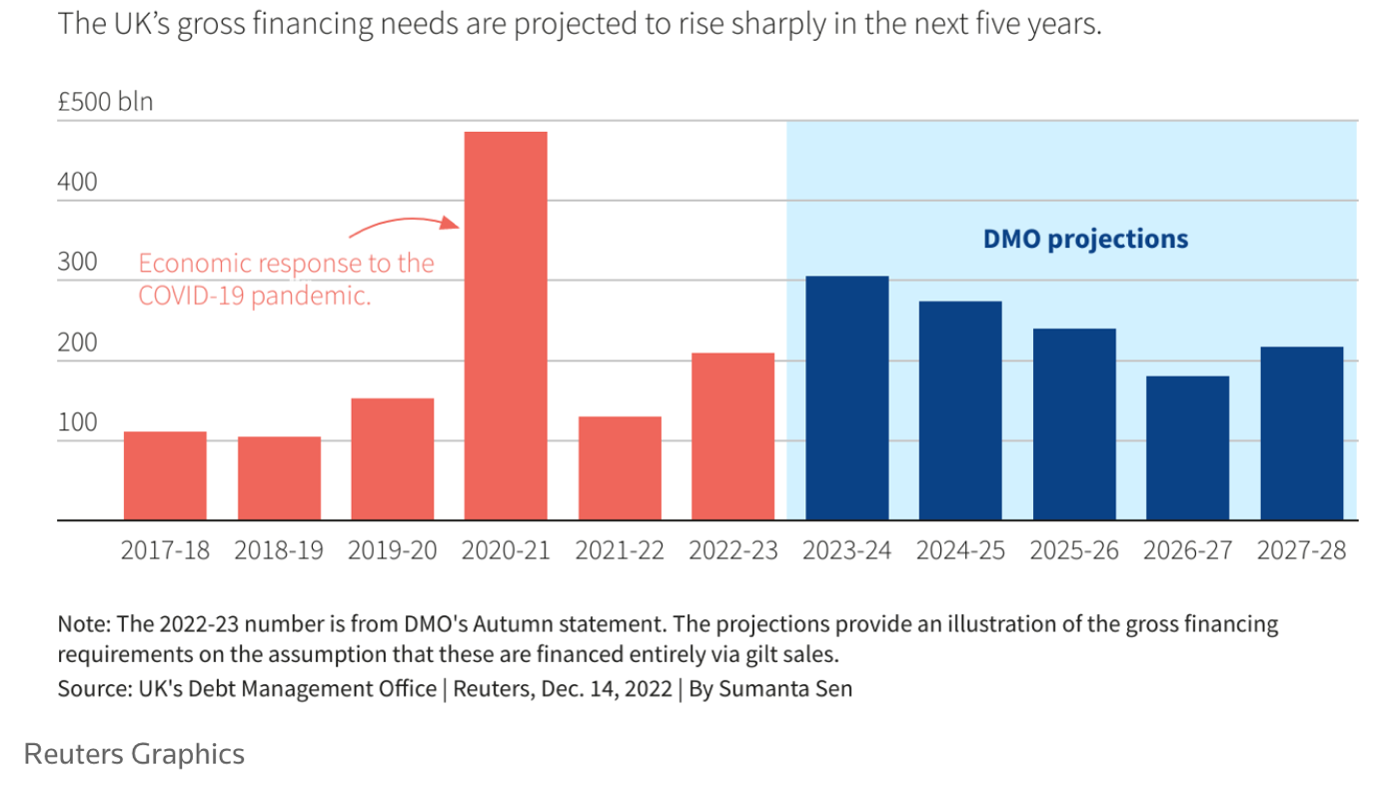
According to consulting firm EY, the capital’s economy will increase by 2.6% per year between 2024 and 2026, vaulting it to the top of the country’s growth chart. According to the analysis, London will have world-class economic development in the following years because of the City’s robust financial and legal industries.
‘The London Plan’ is a road map for London’s future economic growth. With specific steps to accomplish that goal, this plan was developed to make London the best city in the world. The plan emphasizes sustainable and inclusive long-term economic development techniques and specific growth sectors, including e-commerce, tourism, and environmental enterprises. The London Plan recognizes internet-based businesses as one of the industries with the most rapid growth potential. The plan anticipates a robust information and communications technology (ICT) infrastructure to support innovation and the creative and environmental industries.
In 2022, London had one million enterprises, of which 55 percent were small companies with fewer than ten employees. The non-financial companies in London combined generated over £1 trillion in revenue in 2018, making them a significant economic force. 50% of London’s micro-businesses operate in knowledge-intensive industries, compared to the average of 37% for the rest of the UK.
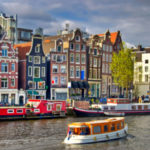
Amsterdam, The Netherlands
Amsterdam is known for its trading history and was, in the 17th century, the world’s financial and trading center. Amsterdam is also home to the world’s oldest stock exchange. The strategic location of the Netherlands is significant for its role as a major commercial center. A natural hub for commerce and industry, the Netherlands is traversed by major European rivers like the Rhine and empties into the North Sea. The City of Amsterdam has held a significant position on the Dutch scene since its beginnings more than 700 years ago.
The Dutch city is a major financial innovation hub, with many companies in the sector, such as ABN AMRO, ING and Adyen, having their head offices there. Many of the largest businesses in the world, including well-known technology companies like Google, Facebook, and Microsoft, Uber, Netflix, and Tesla, have their European headquarters in Amsterdam or are based there.

It’s also well connected digitally with Amsterdam Internet Exchange, one of the world’s largest networks of digital traffic. Amsterdam is not just the economic center of the Netherlands but also an important financial center in Europe. The Philips Group, AkzoNobel, Booking.com, TomTom, and ING are just a few of the significant Dutch corporations with headquarters in the city.
Amsterdam’s GDP was €172 billion in 2018.
The Economist Intelligence Unit and Mercer placed Amsterdam as the 12th best city in the world for quality of living in terms of environment and infrastructure in 2022. In the Savills Tech Cities 2019 study, the city was ranked fourth internationally as a leading tech center (second in Europe) and third in innovation by the Australian innovation organization 2thinknow in their Innovation Cities Index 2009.
Amsterdam has a thriving modern service economy with consultancy, telecommunications, information technology, and medical technology opportunities. Since the outset, international trade and transportation have been cornerstones, and they still make up around one-fifth of all jobs. As expected for a significant financial hub, banking and insurance account for around one-eighth of all occupations, whereas the health, cultural, and social services sectors employ about one-sixth of all workers. The workforce in Amsterdam has comparatively good digital abilities, which aided in the post-pandemic recovery.
Amsterdam is ranked as one of the top 10 expat destinations in Europe.
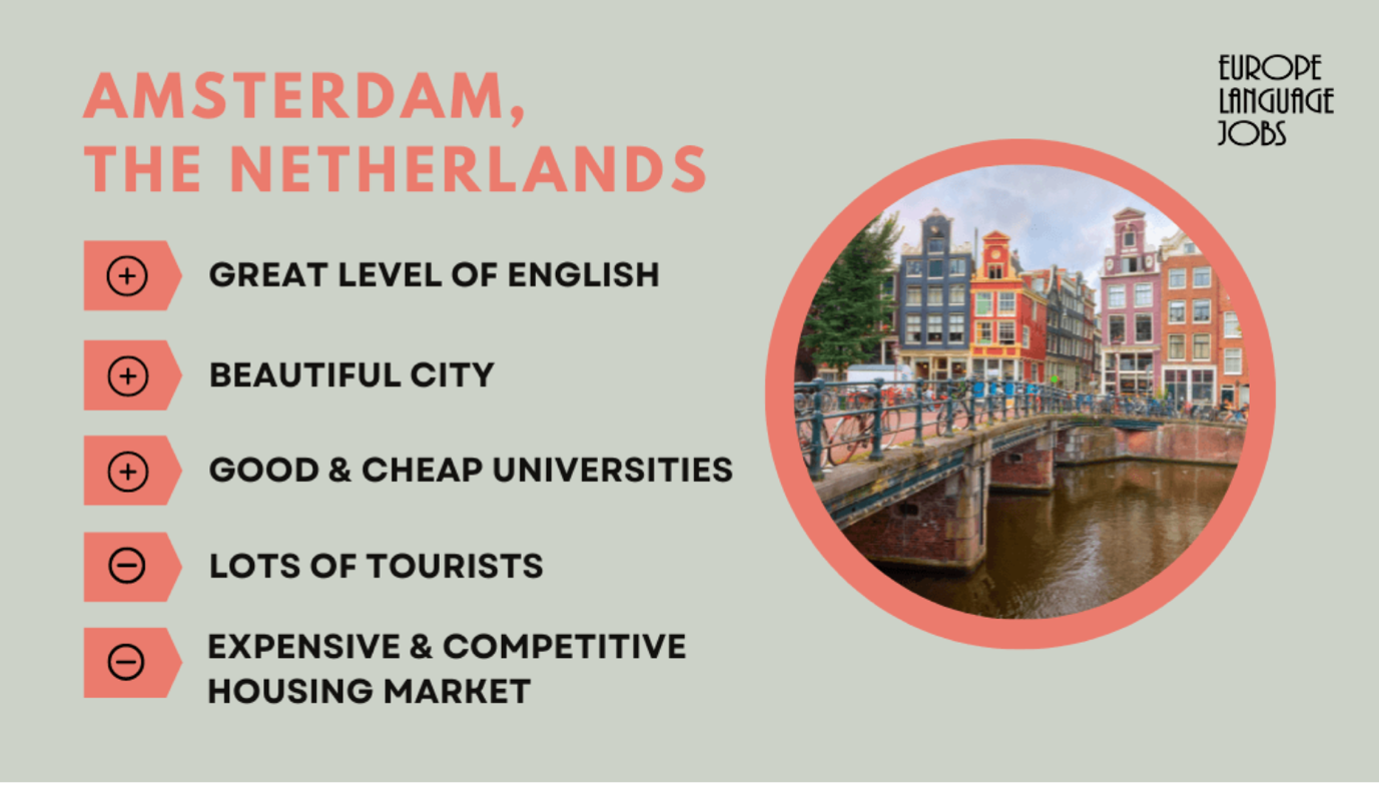
One of the factors that make Amsterdam an attractive location for international business is the very high proficiency level of English speakers. This has made Amsterdam a very competitive player in Europe, and some companies have increased their presence there following Brexit. One of its drawbacks for increased banking presence may be its national banker bonus, which is the strictest in the EU. Bonuses for the financial sector are capped at 20% of salary, which may stop companies from locating in the country.
Despite being the Netherlands’ capital and a significant commercial and financial hub, unlike many other European capitals, Amsterdam does not serve as the country’s administrative center. This adds to its distinctive appeal. Pre-Covid, 20 million visitors each year enjoyed the historical landmarks, outstanding art collections, and unique atmosphere of its historically significant areas. This contributed 90 billion euros to the GDP, but like many other tourist-dominated towns, there is beginning to be a reaction over the social problems brought on by such an influx, such as environmental pollution, traffic congestion, and housing shortages.
Around 10% of all city employees work in the tourism industry. A comprehensive public transportation system includes the modern metro system. Nonetheless, because of its flat terrain, Amsterdam has a significantly higher percentage of its employees cycling to work than many other cities.
Since the middle of the 1960s, Amsterdam has become renowned for having a permissive attitude that draws a lot of people looking for an alternative way of life.
Just approximately half of the city’s residents are native Dutch, which contributes to its international atmosphere, along with a sizable Moroccan and Turkish minority and many people from the previous Dutch empire. Nowadays, just over one-third of Amsterdam’s population is made up of non-European minorities, and the city actively promotes integration through social orientation and language study.
Like many other major cities, the OECD lists housing shortages, labor market imbalances, and environmental concerns as Amsterdam’s three main problems.
Sustainable energy sources are an essential factor in purchasing decisions since sustainability issues also significantly impact sales of data centers and logistical properties, which are crucial to the local economy. This is consistent with the government strategy, which calls for a 49% reduction in greenhouse gas emissions in the Netherlands from 1990 levels by 2030 and a 95% reduction by 2050. All firms must undertake the challenging task of considerably decarbonizing their operations.
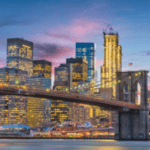
New York City, United States of America
The city early on established itself as a commercial trade hub, formed the New York Stock Exchange Board in 1817 (now NYSE), and overtook Philadelphia as the leader in American finance in 1836. Since the country’s founding, New York City has been recognized as one of the primary regional, national, and international centers for trade and business. Finance was one of New York’s first significant sectors. By the middle of the 1800s, it was already a significant power, and by 1900, it was a contender with London as the global financial hub and surpassed London in the 1920s. Prominent businesspeople and financiers with headquarters in New York City, such as J. P. Morgan and John D. Rockefeller contributed to the city’s rise to prominence. Even though it only held that title for a single year, New York had a crucial role in the formation of the US Congress, the writing and ratification of the Bill of Rights, and the location of the US Supreme Court. Always a populated metropolis, it surpassed Philadelphia in 1835 to become the biggest in the country. This accelerated its development into a commercial and economic hub.
NYC is today one of the leading financial cities in the world, and Wall Street remains the most famous finance area in the world. 45 Fortune 500 companies reside in the city. It’s a global powerhouse in banking, trade, media, art, fashion, education, research, technology, and entertainment. With the United Nations headquarter located there, the city has earned the moniker “world’s cultural and financial capital” and is a significant hub for international diplomacy. The city, which is the biggest metropolis in the United States and one of the biggest cities in the world, had an estimated 8.8 million residents in 2020 and a total population of 20.3 million.
Key global business hubs in NYC include retail, international trade, transportation, new and old media, advertising, legal services, accounting, and insurance. New York City has many Fortune 500 corporations and numerous international businesses. In terms of luring business, investment, and tourism, NYC has repeatedly topped the list of cities around the globe. New York once again outperformed its competitors in the Americas in the 2019–20 edition of FDI’s American Cities of Tomorrow, solidifying its status as a regional economic powerhouse and the top commercial hub. New York Metropolis was also named the top big metropolis in terms of connectivity, lifestyle, human capital, and economic potential.
The financial sector, which makes up 20% of all incomes in the city but only 5% of all private sector jobs, is the most important economic sector in New York. The New York Stock Exchange, NASDAQ, and some of the most prominent commercial and investment banks, including JPMorgan Chase, Citigroup, and Goldman Sachs, are all located in New York City. It serves as an incubator for a variety of financial start-up businesses.
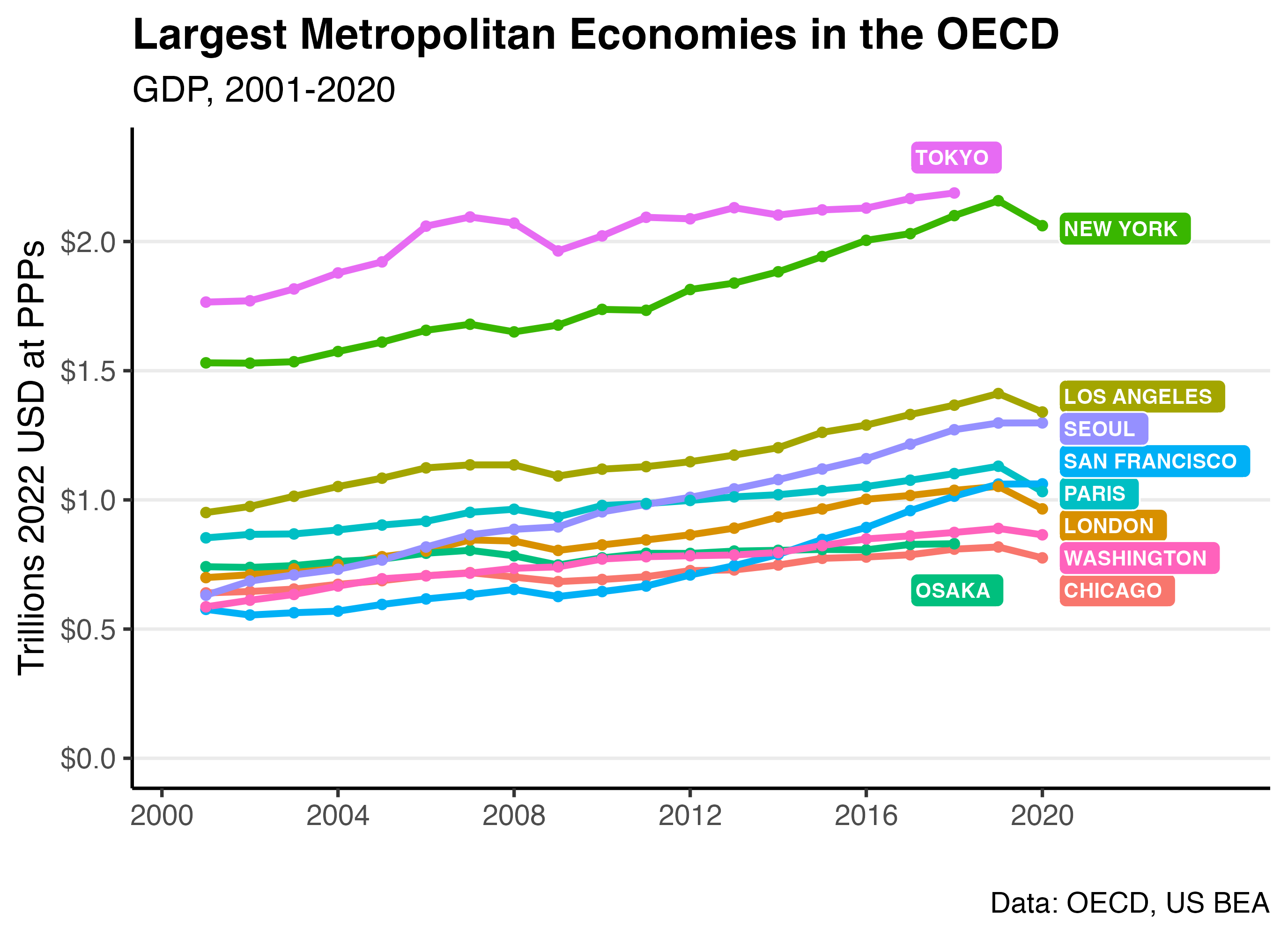
By Noah Friedlander – Own work, CC BY-SA 4.0 www.commons.wikimedia.org
With a gross metropolitan product of more than $2.4 trillion as of 2021, the New York metro region has the most significant urban economy in the world. The New York metropolitan area would have the eighth-largest GDP in the world if it were a sovereign state. Global investors have a well-established sanctuary in New York City. More billionaires, people with an ultra-high net worth (more than US$30 million), and millionaires reside in this city than any other city worldwide.
NYC is also the second biggest tech city in the world and has the world’s largest start-up ecosystem. In 2014, there were 300,000 IT workers in New York City. Venture capital poured approximately US$7.3 billion into New York-based businesses in 2015. The high-tech district of New York is known as Silicon Alley and is continually expanding. High-technology start-up businesses and employment are expanding throughout the metropolitan area, supported by the city’s emergence as a global hub of creativity and entrepreneurship, social tolerance, and environmental sustainability. New York also holds the top spot for North America’s Internet hub and telecommunications center due to its proximity to several transatlantic fiber optic boot lines, intellectual capital, and an e-business ecosystem. Its dominance also means it has developed into the biggest fintech hub in the US.
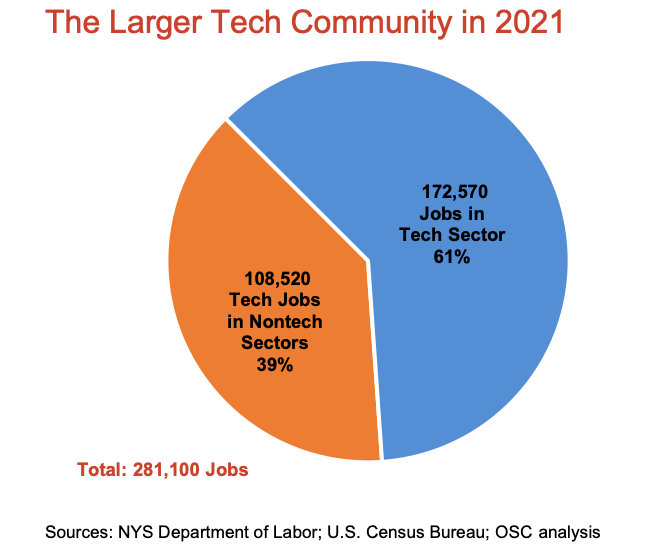
The tech industry does not account for all the growth in tech jobs in New York City. Tech-related jobs, like software developers or computer programmers, are found in businesses outside the tech sector and have grown over the past ten years. As a result, non-tech industries have many tech jobs. The city had 281,100 tech jobs in total in 2021, up 58 percent from 2011. Sixty-one percent of these jobs were in the technology industry.
In New York City in 2021, there were 10,340 IT businesses. The number of IT companies climbed by 34.4 percent (2,650 enterprises) over the previous five years, far more than the 4.5 percent growth in the private sector.
The manufacturing of semiconductors drew attention during the pandemic, in particular, because COVID-19 worsened semiconductor chip shortages. The Governor of New York signed the Green CHIPS legislation in August 2022, increasing the state’s semiconductor manufacturing and job opportunities while reducing emissions. The Excelsior Jobs Tax Credit Program, which offers incentives based on company investment and job creation, will now be open to eligible Green CHIPS projects.
NYC is the most linguistically varied city in the world, with up to 800 languages being spoken there. As of 2016, New York City had the biggest percentage of foreign-born residents of any city in the world, with over 3.2 million residents born outside the United States.
NYC will continue to be a significant player when it comes to the financial services and tech industries, but the outlook is not as bright as it has been earlier. This has more to do with the general global downturn than the city itself. New York has the ability to bounce back though, and has shown time and time again that the city is resilient. New York’s commercial and economic diversity contributes to some of its resiliency. New York has a variety of business pillars, which enables the city to weather difficult events or years, as opposed to relying on a few core industries. Some industries will help the city survive the storm, while others may take longer to recover.
In a tougher business climate, harnessing culture as a driver of success can make a big difference, which is why leaders need to become true culture shapers
Chicago, United States of America
Chicago was founded in the 1830s, grew quickly, and its location meant it developed into an important transportation and trading hub. Manufacturing was early on a significant industry and continues to be so. One of the US Federal Reserve Banks was established in Chicago in 1914.
Chicago continues to be a significant distribution and transportation hub. On top of that, the greater Chicago metropolitan area is home to 36 Fortune 500 organizations. Manufacturing, printing, publishing, food processing, insurance, and financial trading and services are among the city’s most important sectors. Looking back on Chicago’s history, these sectors have long served as the city’s skeleton, expanding and maintaining Chicago as the important metropolis that it has been for more than a century. There are still many outstanding businesses and institutions based in Chicago.
Almost 10 million people call Chicago, the largest city in the metropolitan area, home. With 441 significant business expansions and relocations in 2021, Chicago has ranked first in corporate developments for the past nine years. With a GDP of $812 billion in 2022, Chicago’s economy is among the top 25 economies in the world and ranks third among US metros.
Chicago has a broad economy that rivals that of other countries. After New York and Los Angeles, it ranks third in the US, surpassing developed nations like Switzerland. In addition, Chicago is regarded as having the most balanced economy in the US, primarily because of the diversity of its industries.
The finance industry is one of Chicago’s most prominent and was the sixth-most competitive financial hub in the US as of 2020. (20th in the world). The Loop in Chicago, the second-largest CBD in the nation, is home to the corporate and regional offices of various local, regional, and international organizations. Chicago is one of the leading financial cities in the world. It is the home of 35 Fortune 500 companies across various industries, including insurance and financial trading and services. Chicago has five financial exchanges, including the Chicago Stock Exchange (CHX) and the Chicago Board of Trade (CBOT). Chicago has a significant venture capital presence, and in the past 15 years, venture capital agreements have doubled in Chicago.

Over the last 10 years, it’s also grown into a tech hub to be reckoned with. ChicagoNEXT was founded in 2013 to lure other tech companies to the area. The objective was to draw more IT companies, workers, and investors to the region.
Chicago, which is continuously establishing itself as Silicon Prairie, has attracted scientific and technological investment thanks to Northwestern University, the University of Chicago, and the University of Illinois. Most of the patents in Chicago, which ranks 7th in total patents, are held by individuals. All this fosters the entrepreneurial spirit that has long characterized Chicago. A strategy was implemented to improve the city’s STEM education and IT infrastructure and create an environment that supports talent and motivates it to stay in the area rather than be hired elsewhere.
With twenty-four corporate innovation centers, Chicago is a center for business innovation. Companies such as Oracle, SAP, and Microsoft have offices there. It’s also a hotspot for start-ups, delivering 12 so-called ‘unicorns’ in 2021.

Having the most diversified business economy in the US, there is a lot of potential for innovation in these industries through technology, as can be seen in some of the tech innovations in, for example, the food industry. One of the tech areas that Chicago wants to become a major player in is quantum computing. IT giants like Google and Amazon are located at Lincoln Yards, a city of neighborhoods on the north branch of the Chicago River. Lincoln Yards is a place where specific enterprises can be clustered together. In Q4 2022, the city had almost 250.000 people employed in the tech industry and around 400.000 in business and professional services. Both of these numbers were up from the previous quarter.
Of all US metropolitan areas, Chicago and its surrounding area have the nation’s third-largest science and engineering labor force and the third-largest labor force overall. Its broad range of sectors included anything from aerospace (where Boeing is now located) to food and dining (Chicago is home to McDonald’s, Kraft Heinz, Quaker Oats, and Mondelez International, among others). Since the city’s founding, retail has also played a vital role in its economy. Today, Chicago is home to companies like Walgreens, Sears, Ace Hardware, and Crate & Barrel.
Chicago is also a significant player when it comes to conference hosting. After Las Vegas and Orlando, it holds the most conventions annually in the US and has the third-largest convention center in the world. Chicago is one of the biggest international hubs in the US due to its location in the middle of the country. It links the East and West Coasts and has drawn many significant corporations to locate their corporate headquarters in the metropolitan area.
This city has a thriving small business community, and previous mayor Rahm Emanuel even introduced pro-business policies to help small enterprises grow. With the help of the Small Business Advisory Council, Chicago’s small businesses were supported by the reduction of red tape and excessive adherence to formal rules to maximize growth. Because of high start-up costs and generalized rules that penalize small enterprises, it is difficult for them to grow during their first few years of operation. A 60% reduction in license categories was made in 2013, saving thousands of small firms approximately $2 million yearly. To foster a more business-friendly atmosphere, the employee head tax was likewise phased out and repealed, saving Chicago’s small businesses upwards of $9 million a year.
Chicago, the third-largest city in the US, is an important transportation hub for the Midwest and a critical network for the movement of people and goods. Being the sixth busiest airport in the world, O’Hare International Airport handles over 2,500 aircraft operations daily and provides non-stop service to over 200 international locations.
Chicago is ready for the future.
It will continue to be a top American city for decades thanks to its strong and diverse economy, a wide range of industries, competitive salaries, deep roots, and forward-thinking mindset.
Program Benefits
Management
- Leadership excellence
- Increased collaboration
- Greater innovation
- Emotional intelligence
- Inclusive environment
- Effective communication
- Increased engagement
- Increased productivity
- Strength utilisation
- Empowered employees
Human Resources
- Greater retention
- Productive workplace
- Enhanced culture
- Effective teams
- Increased engagement
- Empowered employees
- leadership excellence
- Improved relationships
- Talent retention
- Collective intelligence
Information Technology
- Change management
- Digital transformation
- Hybrid teams
- Online collaboration
- Emotional intelligence
- Stakeholder management
- Effective communication
- Future readiness
- Customer experience
- Employee experience
Testimonials

Testimonial 1
Content here…

Testimonial 2
Content here…

Testimonial 3
Content here…

Testimonial 4
Content here…

Testimonial 5
Content here…
More detailed achievements, references and testimonials are confidentially available to clients upon request.
Client Telephone Conference (CTC)
If you have any questions or if you would like to arrange a Client Telephone Conference (CTC) to discuss this particular Unique Consulting Service Proposition (UCSP) in more detail, please CLICK HERE.














